Create a new rich message
This topic relates to Whispir’s Rich Message Studio (not to Whispir’s ‘classic’ messaging).
Follow the steps below to create and then send a new rich content message using a template in Whispir’s Rich Message Studio.
Tip! You can also create a message from scratch in the Rich Message Studio. This involves adding and editing the default components provided by Whispir or adding components that you’ve already saved. But it’s much easier if you find a template that closely matches what you want and then edit it to suit your needs.
Note: The Voice channel is not available for messages created in the Rich Message Studio.
Steps
- Ensure that the required workspace is on the Workspace toolbar.
- Hover over the workspace to view the Workspace menu.
- Under Messages click Quick Rich Message. (If you can’t see it, click More to view more commands.)
The My Templates page that opens displays the templates that have been saved for the current workspace (that is, templates that users have either created by saving an existing template with a new name or created from scratch).
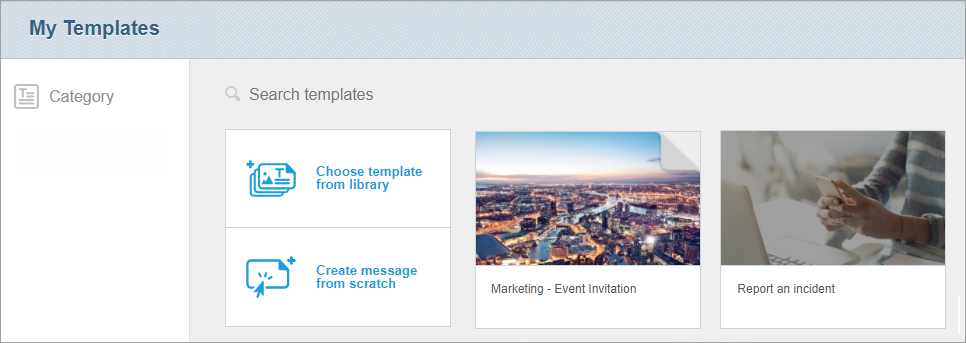
You can either choose a template that has been saved to the workspace’s My Templates page or choose one from the Template Library.
- Find the template on the My Templates page or click Choose template from library and find it in the library.
- To preview the template hover your mouse over it and click Preview.
The page shows you how the message will appear on a desktop computer or mobile phone. Click a channel selector to switch between different content views.- If you want to use this template click Edit in the progress bar, and then go to Step 3. Edit the template content.
Tip! You can scroll down the page or use the Search function or find it by category in the Category pane on the left.

- To use a template without previewing it hover your mouse over the template and then:
- Click Use.
- When the template opens click Edit in the progress bar (if not already selected).
The content in the template you selected is built from components. You now need to review and edit those components on each of the channels that you want to use in your message. And you can also add components to it from the Components Library. See Use the rich message/template components for more information.
Note: On the My Saved Components tab of the Components Library watch out for the icon with a blue triangle in the top right corner ![]() . It indicates your older saved components, which can’t be used with new messages or templates.
. It indicates your older saved components, which can’t be used with new messages or templates.
At the Edit step:
- The channel selector shows the available channels (such as Mobile, Email and Web). (The Social and Custom channels are only shown if your company is using these channels.)
- The currently active channel is highlighted.
- A green tick
 indicates channels that already contain content.
indicates channels that already contain content. - If you don’t want to use a particular channel but it already contains content you can delete that content. Hover your mouse over each component and click the delete icon
 .
. - The Components Library pane is open on the right.
- You can add @@ tags (at-at tags) to your content to automatically insert system, recipient and sender information when the messages are sent. See About @@ tags (at-at tags).
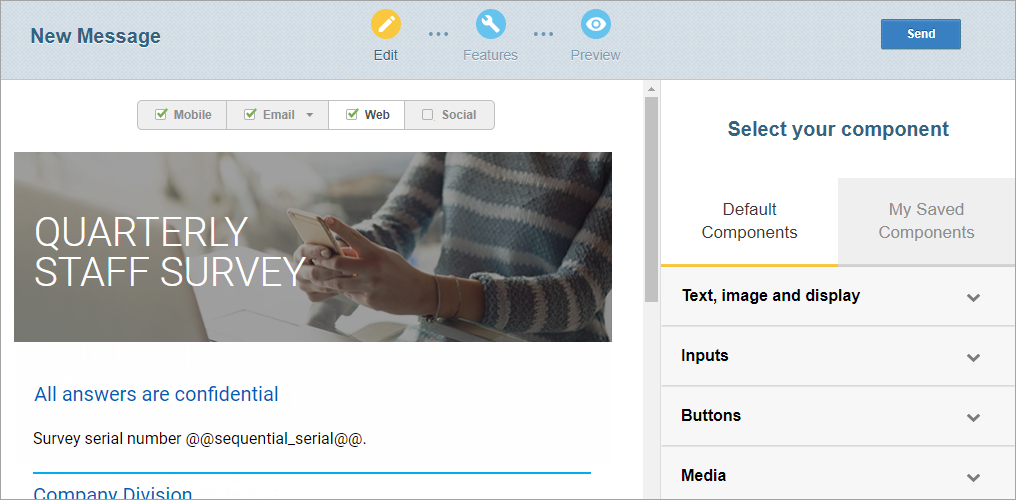
Note: When you double-click a component in your message the editing pane opens on the right in Content mode. It displays all the editable properties for this component. Clicking Code switches to Code mode. It can give you greater control over your changes but you should only use it if you’re experienced in editing HTML code.
Note: You can only add plain text in the Mobile channel. You can’t include rich content in an SMS message.
- Select the Mobile channel.
- If there is no content yet find the Plain Text component in the Components Library (under Text, image and display) and either click
 beside it or drag it onto the message.
beside it or drag it onto the message. - Hover your mouse over the component and click the edit icon
 .
.
The editing pane opens on the right in Content mode. - In the Plain Text property type add or edit the text.
The changes are immediately reflected in the content on the left. - Click Done.
Warning! Try to keep your message short. Be aware that a message that uses @@ tags (particularly the @@web_link@@ tag), special symbols, variables or different language character sets might hit the single message size limit more quickly. If it gets split over multiple messages your company will be charged for each one. See About SMS message length and About @@ tags (at-at tags) for more information.
By default Whispir sends the email as a rich content email (that is, its content is in HTML format). If you specifically need to send a plain text email message you can do this as well.
- Select the Email channel.
- If you only want to send a rich content email go to Step 3.
- If you want to override the default mode and create both a rich email and a plain text email (or just a plain text email) go to Step 2.
- Do the following:
- Click the arrow beside Email.
- Click the link
 icon.
icon.


- Click Rich Email or Text Email to activate either option, as required.
- If there is no content in the Email channel yet, go to the Components Library and:
- Expand a category to find the required component.
- Click
 beside the component or drag it onto the template.
beside the component or drag it onto the template.
- In the message hover your mouse over the component and click the edit icon
 .
.
The editing pane opens on the right in Content mode. It displays the editable properties, grouped by property type. The main property type is expanded automatically. - Expand a property type and add or edit the details.
The changes are immediately reflected in the content on the left. - Click Done to close the editing pane.
- Add and edit all other components as required.
- Reorder your components if you need to: Hover your mouse over a component, click the move icon
 and drag the component to its new position.
and drag the component to its new position.
You can add rich content to the Web channel – formatted text, images and interactive features. In fact, anything that can appear on a web page can be included.
Important! If you’re using the Web channel ensure that you also add the @@web_link@@ tag to your content in all other relevant channels. This will insert a URL link to the web content into those message channels when the message is sent. See About @@ tags (at-at tags).
- Select the Web channel.
- If there is no content in the Web channel yet, go to the Components Library and:
- Expand a category to find the required component.
- Click
 beside the component or drag it onto the template.
beside the component or drag it onto the template.
- In the template hover your mouse over the component and click the edit icon
 .
.
The editing pane opens on the right in Content mode. It displays the editable properties, grouped by property type. The main property type is expanded automatically. - Expand a property type and add or edit the details.
The changes are immediately reflected in the content on the left. - Click Done to close the editing pane.
- Add and edit all other components as required.
- Reorder your components if you need to: Hover your mouse over a component, click the move icon
 and drag the component to its new position.
and drag the component to its new position.
Note: You can quickly apply a theme to your Web channel content by using a Shared Template Styles component. See Use the Shared Template Styles components.
The Social channel is only available if it has been configured for your company. It allows you to publish messages to social media services (such as to your company’s Twitter, Facebook and LinkedIn accounts) or to other types of end point (such as an RSS feed, or a document file or XML file).
Depending on how the channel has been set up, you can enter the message content directly into the Social channel fields or it can be pulled automatically from any of the other channels.
To add or edit content for this channel, follow the process that has been put in place for your company. Remember to also complete the details on the Publishing tab at the Features step. See Understand a message’s Features settings.
The Custom channel is only available if it has been configured for your company. It’s effectively an extension to the Social channel, providing a second avenue for publishing messages to a range of end points, such as Twitter, Facebook, LinkedIn, RSS feeds, or a document file or XML file.
It can be used to support messaging needs that are much more complex than standard messaging (for example, fire emergency warning messages that display on a website’s Home page).
Depending on how the channel has been set up, you can enter message content directly into the Custom channel fields or it can be pulled automatically from any of the other channels.
To add or edit content for this channel, follow the process that has been put in place for your company. Remember to also complete the details on the Publishing tab at the Features step. See Understand a message’s Features settings.
You can apply a range of advanced features to a rich message to give you more control over it.
- Click Features in the progress bar to go to the Features step.
- Click each tab in the Features steps to activate the required options and enter further details where required.
See Understand a message’s Features settings for more information about each setting. - Go to Step 5. Preview your message.
The Preview step lets you check how your message will display to recipients.
- Click Preview in the progress bar.
The page shows you how the message will appear on a desktop computer or mobile phone. - Click a channel selector to switch between different content views.
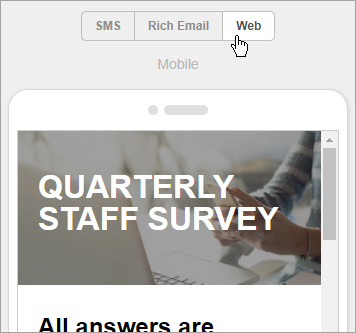 .
.- If you need to make further changes click Edit in the progress bar.
- Go to Step 6. Send your message.
- Click Send to the right of the progress bar to open the Send Message pane.
You now need to add the message recipients. You can also edit the subject line and add a label and a category to the message.
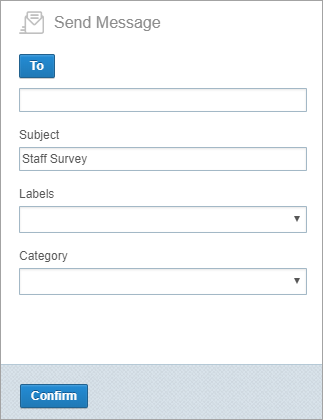
You use the Address Book to add one or more message recipients to your message (particularly by selecting distribution lists).
Tip! You can also enter recipients directly into the To field if you know their phone numbers or email addresses. Separate the entries with a semicolon (;) and one space. If a recipient is a contact in Whispir they’ll receive your message via whichever channels are configured in their contact profile.
- Click To to open the Address Book.
- In the first field in the Contacts section select an option – either Contacts or Distribution List.
You can use the search filter options in the Contacts section to locate particular recipients in the Address Book:
- Select a search filter option from the drop-down list and type a term in the field beside it.
For example, select First Name and then type ‘John’ in the field next to it to find contacts called John, or type J to find all users with a first name that contains the letter J. - To help you further refine your search you can add more search criteria:
- Click
 to display another filter field. Select the check box beside it to indicate you want to apply this criterion.
to display another filter field. Select the check box beside it to indicate you want to apply this criterion. - Click
 to add more fields and select your criteria.
to add more fields and select your criteria.
Tips:
- You can add multiple terms, separated by commas, to the search field beside the drop-down list. For example, entering ‘Tinh, Bill, Sue’ when you select First Name returns contacts with these first names, as well as names starting with these letters.
- The last search filter you applied is retained. That is, you’ll see the same search results the next time you open the Address Book until you change the filter.
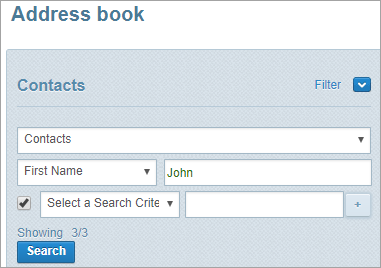
- Click Search.
- Select the recipients in the left pane and click To, Cc or Bcc, as required, to add them to the Recipients pane.
(Press and hold the CTRL key to select multiple separate entries, or press and hold the SHIFT key to select a block of entries.) - ‘Cc’ copies the message to the nominated recipients. Other recipients will see the recipients’ names in the email.
- ‘Bcc’ blind copies the message to the nominated recipients. Other recipients won’t see these names.
- To remove someone from the Recipients pane click Del beside their name.
- If you added a distribution list to the Recipients pane you can click the
 icon to expand it and view its members.
icon to expand it and view its members.
All group members are selected by default, but you can clear check boxes against any individuals you don’t want to send the message to. - Click Ok.
Tip! To quickly add a single recipient, enter their email address or mobile phone number (with no spaces) in the Quick Send field and click To, Cc or Bcc.
The Address Book closes and the selected recipients are listed in the message’s To field.
You can add a subject, label and category to the message:
- Subject: This is an important field. It’s used both as the subject line in the email message and as searchable content in Whispir itself.
- Label: Adding a label allows messages to be grouped in any message list view (such as on the View My Messages page). For example, applying a label that refers to a particular incident lets you easily filter for all related messages in a message list.
- Categories: Adding categories allows messages to be more readily searchable in Whispir.
- (mandatory) In the Subject field edit the subject if required. Ensure that it’s a brief but meaningful description of the message.
- (optional) In the Label field select a label.
- (optional) In the Category field select a category.
Note: If your company uses either the Events module or the Event Studio the list may include predefined event labels.
- At the bottom of the Send Message pane click Confirm.
Your message is sent.
The View My Messages page opens, listing your sent message. You can click Status beside the message to review its status (who has received it, who has responded and so on). See View and understand a sent message’s status.